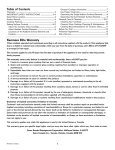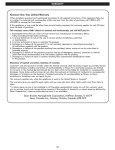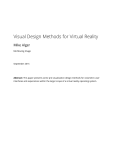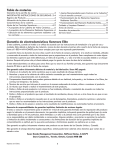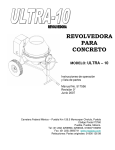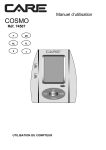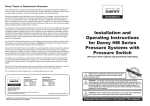Download Dear Colleague, Thank you for visiting our website and
Transcript
Dear Colleague, Thank you for visiting our website and downloading a product catalog from the R.M. Hoffman Company. We hope this information will be useful to you in solving the application you are working on. The R.M. Hoffman Company is located in the Silicon Valley and has been in business for over 50 years. We are engineers who specialize in mechanical components such as gearboxes, flex couplings, rotary unions, and torque releases, as well as hardware items such as actuators, brakes, clutches, and electrical slip rings. We sell our solutions worldwide to semiconductor, medical, packaging, robotic machine and other builders. Quite often we find that our customers want a customized version of standard product offerings and we take pride in our ability to help match our customer’s engineering requirements to the exact product needed. We work closely with our customers to provide modified products or an assembly of products. Please give us a call and let us know how we can assist you. We look forward to talking to you soon. Thank you. The R.M. Hoffman Team 408-739-6580 info@rmhoffman.com R.M. Hoffman Company • 159 San Lazaro Avenue, Sunnyvale, CA 94086 • 408.739.6580 • [email protected] • www.rmhoffman.com SERVICE MANUAL TORQ-GARD™ OVERLOAD CLUTCH The Driving Force in Automation WARNING This is a controlled document. It is your responsibility to deliver this information to the end user of the CAMCO/FERGUSON product. Failure to deliver this could result in your liability for injury to the user or damage to the machine. For copies of this manual call your Customer Service Representative 800-645-5207. ™ torq/gard mechanical torque-limiting overload clutch Installation–Operation and Maintenance Instructions 1. Read your Torq-Gard Installation-Operation Instructions thoroughly before operating the unit, for your safety and the protection of your equipment. 2. Double check to be sure the power is off and cannot be turned on while working on the equipment. 3. Electrical power should be disconnected at the fuse box, circuit breaker or motor starter. 4. The Torq-Gard Clutch is designed to protect your machine and will not protect against bodily injury. 5. Keep all objects such as hands, clothing, tools, etc. away from rotating or moving parts. 6. Use safety glasses or equivalent to protect your eyes. 7. Do not manually re-engage the Torq-Gard Clutch. (Refer to “Automatic Reset” instruction.) 8. Do not adjust the torque while the clutch is disengaged. (Refer to “Torque Setting” instruction.) 9. Do not exceed the recommended maximum RPM. (Refer to Torq/Gard Rating Chart.) 10. The detector mechanism must electrically disconnect the prime mover at the recommended RPM settings. (Refer to “Overload Detection” instruction.) 11. Shaft mounting set screws must clear the mounting bosses or the clutch will not release upon overload. (Refer to “Mounting the Torq/Gard” instruction.) 12. Shaft and detector mounting set screws must be tight and the recommended number used. (Refer to “Mounting the Torq/Gard” instruction.) The above list includes major safety points to be observed, but should not be considered as limiting in safety precautions to be followed. Browning Torq/Gard single strand sprockets, for No. 40, 60, 80, and 100 ANSI Standard Roller Chain Drives, mount directly to the clutch. Browning Torq/Gard Gearbelt Pulleys are also available for 1/2” Pitch Belts. Before mounting the clutch on the driving or driven shaft, your choice of coupling or sprocket should be attached to the Torq/Gard Clutch. Sprocket Installation Browning Torq/Gard Single Strand Sprockets register with the drilled and tapped mounting lugs on the adapter end of clutch. Torq/Gard Chain Drives can be used as the driving or driven member. See page 6 for sprocket availability. 1. Place the sprocket on the registered mounting lugs. 2. Select the correct length Hex. Head Cap Screws (3 required) from Table A. Warning: Short Screws may strip the mounting lug threads. 3. For maximum locking effect, (medium) spring lock washers should be used under the Hex. Head Cap Screws. Table A–Sprocket Mounting Hardware TG3/6 TG20 TG60 TG200 TG400 TG800 Operating Principle TG35A__K 20TG40A__K TG40A__K TG60A__K TG80A__K TG100A__K #8-32 X .50 HHCS #10-24 X .62 HHCS 1/4-20 X .75 HHCS 3/8-16 X 1.00 HHCS 1/2-13 X 1.50 HHCS 1/2-13 X 1.75 HHCS Gear Belt Pulley Installation Torq/Gard Overload Clutches help protect the entire drive train of your machinery from damage due to excessive torque generated by overloads and jamming. The torque is adjusted by turning the single hex-socket head control which adjusts the Torq/Gard Clutch precisely to any setting within its load range. A spring-loaded cam follower seated in a single hub cam detent causes the hub and clutch body to rotate as a unit. The two point contact of the follower produces equal forces within the cam detent, minimizing the effect of “breathing”, found in conventional clutches. When the pre-set torque limit is exceeded by an overload condition, the follower is instantly released from the cam detent, disconnecting the hub from the body. Either the hub or the body may be used as the input or output. NOTE: During overload, the Torq/Gard produces a loud audible report, which is a normal operating characteristic of the clutch. In direct coupled applications, the modular designed Torq/Gard can be used with Browning Ever-Flex Couplings or Chain Coupling Kits, without modification to the clutch or couplings. Split taper bushings are available for the coupling output. Follow the above mounting instructions for the Browning Torq/Gard Gear Belt Pulleys, using the longer Hex. Head Cap Screws supplied with the pulleys. Chain Coupling Installation 1. Select the Browning Chain Coupling components from page 6 for the applicable Torq/Gard Model. 2. Mount the single strand sprocket per the above “Sprocket Installation” instructions. 3. Place the Split Taper Bushing Sprocket over the Single Sprocket, with the corresponding teeth in alignment. 4. Secure the two sprockets by wrapping the double strand roller chain around the sprockets, insuring that the sprocket teeth fully engage the chain. 2 5. Insert the chain connecting link in the chain ends and lock with the spring clip (supplied with the connecting link). When assembled correctly, the Split Taper Bushing Sprocket will “float”, for maximum misalignment capability. Table B–TGC60 Clutch Detector End Set Scr. Length (2) Reqd. Shaft Dia. to Retain Detector Cam .750 Dia. .190-32UNF-2A x .75 Lg. .9375 Dia./1.125 Dia. .190-32UNF-2A x .62 Lg. 1.250 Dia. .190-32UNF-2A x .50 Lg. Ever-Flex Coupling Installation 1. Select the correct Ever–Flex Coupling and Adapter Plate from page 6. 2. Attach the Adapter Plate to the Torq/Gard mounting lugs with three (3) Allen Flat Head Cap Screws supplied with the adapter. 3. Mount the Ever-Flex half coupling on the Adapter Plate with the eight (8) Hex. Head Cap Screws supplied with the Adapter Plate. (Quantity 10 Hex. Head Cap Screws are supplied with Adapter Plate 400CAP9 and 800CAP10.) Set Scr. Length (1) Reqd. to Retain Detector Cam Over Key .190-32UNF-2A x .38 Lg. .190-32UNF-2A x .38 Lg. .190-32UNF-2A x .38 Lg. Adapter End Set Scr. Length (2) Reqd. @ Adapter End Shaft Dia. of Clutch .750 Dia. .190-32UNF-2A x .50 Lg. .9375 Dia./1.125 Dia. .190-32UNF-2A x .38 Lg. 1.250 Dia. .190-32UNF-2A x .25 Lg. Set Scr. Length (1) Reqd. Over Key @ Adapter End of Clutch .190-32UNF-2A x .19 Lg. .190-32UNF-2A x .19 Lg. .190-32UNF-2A x .19 Lg. Table C–TGC200 Clutch Detector End Mounting The Torq/Gard The Torq/Gard Clutch hub is machined to its maximum bore diameter. Shafts smaller than the maximum diameter are accommodated with standard Browning Torq/Gard Bushing Kits as shown on page 6. The bushing kits are complete with bushing, key and shaft set screws. Note: Six (6) set screws are supplied in four (4) lengths. Warning: The correct length set screws must be used as the clutch will not release if the set screws extend beyond the hub and hit the adapter mounting lugs. The Torq/Gard Clutch can be shaft mounted from the adapter or detector end of the hub. The required shaft set screw lengths vary depending on the bushing selected. They will also vary in length if used on the detector end in conjunction with the detector mechanism. Tables B, C and D include all set screw combinations for any bushing or mounting option. Example 1: A TGC60 Clutch requires a .750 inch diameter shaft mounted on the adapter end. Selection: A Browning 60BU012 Bushing Kit is chosen from page 6. The correct set screws from Table B (adapter end): Qty. 2 .190-32UNF-2A x .50 Long Qty. 1 .190-32UNF-2A x .19 Long (over key) Example 2: A TGC60 Clutch requires a .750 inch diameter shaft mounted on the detector end with the detector mechanism. Section: A Browning 60BU012 Brushing Kit. The correct set screws from Table B (detector end): Qty. 2 .190-32UNF-2A x .75 Long Qty. 1 .190-32UNF-2A x .38 Long (over key) NOTE: If the Bushing was used on the detector end without the detector, the selection would be the same as Example 1. Shaft Dia. .9375 Dia./1.250 Dia. 1.250 Dia./1.500 Dia. 1.500 Dia./1.750 Dia. 1.750 Dia./1.9375 Dia. Set Scr. Length (2) Reqd. to Retain Detector Cam .250-20UNC-2A x 1.0 Lg. .250-20UNC-2A x .88 Lg. .250-20UNC-2A x .75 Lg. .250-20UNC-2A x .62 Lg. Shaft Dia. .9375 Dia./1.250 Dia. 1.250 Dia./1.500 Dia. 1.500 Dia./1.750 Dia. 1.750 Dia./1.9375 Dia. Set Scr. Length (2) Reqd. @ Adapter End of Clutch .250-20UNC-2A x .75 Lg. .250-20UNC-2A x .62 Lg. .250-20UNC-2A x .50 Lg. .250-20UNC-2A x .38 Lg. Set Scr. Length (1) Reqd. to Retain Detector Cam Over Key .250-20UNC-2A x .50 Lg. .250-20UNC-2A x .50 Lg. .250-20UNC-2A x .50 Lg. .250-20UNC-2A x .50 Lg. Adapter End Set Scr. Length (1) Reqd. Over Key @ Adapter End of Clutch .250-20UNC-2A x .25 Lg. .250-20UNC-2A x .25 Lg. .250-20UNC-2A x .25 Lg. .250-20UNC-2A x .25 Lg. Table D–TGC400 and TGC800 Clutch Detector End Set Scr. Length (2) Reqd. Shaft Dia. to Retain Detector Cam .375 Dia./1.688 Dia. .375-16UNC-2A x 1.25 Lg. 1.750 Dia./2.125 Dia. .375-16UNC-2A x 1.00 Lg. 2.125 Dia./2.4375 Dia. .375-16UNC-2A x .88 Lg. Set Scr. Length (1) Reqd. to Retain Detector Cam Over Key .375-16UNC-2A x .62 Lg. .375-16UNC-2A x .62 Lg. .375-16UNC-2A x .62 Lg. Adapter End Set Scr. Length (2) Reqd. @ Adapter End Shaft Dia. of Clutch 1.375 Dia./1.688 Dia. .375-16UNC-2A x .88 Lg. 1.750 Dia./2.125 Dia. .375-16UNC-2A x .62 Lg. 2.125 Dia./2.4375 Dia. .375-16UNC-2A x .50 Lg. Set Scr. Length (1) Reqd. Over Key @ Adapter End of Clutch .375-16UNC-2A x .38 Lg. .375-16UNC-2A x .38 Lg. .375-16UNC-2A x .38 Lg. 1. Select the Browning Torq/Gard Bushing Kit from page 6. 2. Refer to tables B, C or D for the correct shaft set screws. (3 required) 3. Slide the bushing with the mating key on the shaft. Note: The use of LOCTITE C5 - Anti-Seize lubricant is recommended to ease assembly of the bushing to the shaft and the Clutch to the bushing. 4. The shaft length must be at least equal to the bushing length to insure engagement of the Torq/Gard bearings. Limited shaft lengths or high overhung load applications require additional outboard bearing support. Browning Bushings are manufactured specifically to fit the entire length of the hub which provides additional support. Again, check Tables B, C or D to insure that the correct length set screws are used and that they will engage the shaft. 5. Apply Perma-Lok HM118 to the set screws and mating tapped holes in the Clutch hub. 3 Warning: High inertia loads, reversing loads, excessive vibration or continual tripping may require the use of Perma-Lok HM160. 6. Tighten set screws against shaft and key. Warning: Check to insure that the set screws do not extend beyond the hub on the adapter end. When used on the detector end the set screws must also engage the detector cam, but must not extend beyond the detector cam. Typical Wiring Diagram Overload Detection The axial movement of the Detector Mechanism, when used in conjunction with a limit/prox. switch, electrically disconnects the prime mover (motor) from the load. The Detector Mechanism consists of a spring loaded plate mounted on the clutch cover plate cam. When an overload occurs, the cam releases the detector plate a sufficient distance to actuate a limit/prox. switch. When the overload has been cleared, the re-engagement of the clutch automatically resets the detector mechanism. Warning: Detector systems are recommended on all applications and mandatory on the following: Figure 3 6. The detector mechanism can be installed in the field. A. Place the three (3) detector springs in the three shallow holes in the Torq/Gard cover. B. Place the “white” detector plate guide pins in the three deep holes in the cover. Note: The pins are registered to fit in one position only. C. Place the “black” detector cam on the clutch hub with flat side up. D. Rotate the cam until each cam lobe is directly over the detector plate ears and the set screw holes are aligned with the set screw holes in the hub. Note: The clutch must be in its engaged position for proper alignment of the detector mechanism. E. Secure the detector cam to the clutch hub with the correct length set screws, using Perma-Lok HM118. (Refer to Tables B, C or D for the correct shaft set screws.) Warning: Factory mounted detector mechanisms utilize set screws for shipping purposes only. The correct length of the set screws is determined by the shaft diameter used. TG60/TG200 - At speeds over 100 RPM TG-400/TG800 - At all speeds Infinitely high shock loads can occur, depending on the type of jam or overload. The detector system further protects your equipment under these conditions. On high inertia applications, breaking the prime mover may have to be considered. 1. The limit/prox. switch must have a rigid mounting. 2. Locate the limit/prox. switch so the detector plate travel will acuate the limit/prox. switch. Note: Refer to Figure 1 and Figure 2 for typical installations. Figure 1 mounting is preferred for reasons of rigidity. Figure 1 Torque Setting The torque is infinitely adjustable within the nameplated torque limits of the clutch. Determine the operating and tripping torque required to drive your machine. A. Operating torque is the normal full load torque required by the application. B. Tripping torque, which is usually higher than operating torque, depends on the starting torque requirements of the application and the location of the Torq/Gard Clutch. C. Mounting the clutch away from the motor tends to absorb peak starting torques through power transmission and machine components. (Refer to Fig. 4.) D. Tripping torque should be set higher than the point at which the clutch will “nuisance trip” on starting, but below the maximum torque value the machine can safely absorb. Figure 2 3. Refer to the Torq/Gard dimension prints on page 5 for the detector plate “travel”. 4. When mounting the limit/prox. switch, consult the manufacturer’s specifications for pre-travel and overtravel. 5. Wire the limit/prox. switch in parallel with the “start” contactor to permit motor starting after the overload has been cleared. Note: Refer to Figure 3 “Typical Wiring Diagram”. Limit/prox. Switches are available with additional contacts to further acuate warning alarm systems. Figure 4 Direct Drive application with the Torq/Gard mounted on the low speed output shaft of the reducer. The Torq/Gard is shown with a Browning Ever-Flex half coupling which mounts on the clutch adapter without modification. Browning Chain Coupling Kits are also available for the Torq/Gard when greater misalignment capabilities are required. Either side of the Torq/Gard can be used as the input. 4 The Torq/Gard should not be used on the high speed input side of the reducer. Clutch sensitivity becomes a function of the reducer’s gear ratio. As an example, when used with a 100 to 1 reducer, a 100 inch-pound torque variation on the output side will reflect only a 1 inch-pound change on the input side. Do not exceed the maximum RPM shown in the Torq/Gard selection table. The Torq/Gard may also be sized by applying one of the following formulas: Torque (In.-lbs.) = Horsepower (HP) x 63025 RPM OR Horsepower = Mounting the clutch on the output of the gear motor or reducer provides the most economical clutch assembly. The Torq/Gard is designed to protect the weakest link in the drive system. Tripping Torque = Operating Torque x Service Factor Note: The nameplate contains a sensitized “rectangle” on which the torque setting may be recorded with ball point pen or a numbering die. Warning: The Torq/Gard Clutch is not a “FAIL SAFE” device and cannot be used on “overhauling” or “holding” load applications. The Torq/Gard is mounted on the driven machine and powered through a chain and sprocket drive. Mounting the clutch in this position tends to absorb peak starting torques. TORQ / GARD RATINGS The Torq/Gard Clutch is delivered with the torque set at the low end of its torque range. 1. Turn the single Hex.-Socket Head adjusting nut clockwise to increase the Torque Setting. (Refer to Table E.) Note: 1/2 inch Hex-Keyed (Allen) Wrench is required. Torque (in.-lbs.) Table E MODEL TG-3 TG-6 TG-20 TGC60 TGC200 TGC400 TGC800 APPROXIMATE TORQUE (IN.-LBS.) PER TURN 2.67 4.4 11 50 100 225 450 Torque (In.-lbs.) x RPM 63025 MAXIMUM TURNS 7.5 7.5 13 8 11 9 9 HP RPM Weight Inertia Models Min. Max. Max. Max. (lbs.) (WK2) Max. (inches) Bore Dia. TG-3 13 32 1.5 1800 1.5 1.4 1/2 TG-6 23 56 2.5 1800 1.5 1.4 1/2 TG-20 56 203 4 1800 2.5 5.7 3/4 TGC 60 200 600 8.5 900 5.5 10 1-1/4 TGC 200 600 2000 21.5 680 12 46 1-15/16 TGC 400 2000 4000 22.2 350 38 455 2-7/16 TGC 800 4000 8000 44.4 350 38 455 2-7/16 Automatic Reset The Torq/Gard Clutch is automatically reset by “jogging” the motor after the overload has been corrected. At speeds under 50 RPM the Torq/Gard will re-engage, without jogging, upon starting the motor. The clutch will not re-engage if the overload exceeds the torque setting. Warning: Do not re-engage the Torq/Gard manually. When the clutch snaps into engagement, injury could occur if the operator’s hand is near a chain and sprocket or belt drive. 2. Sighting the front face of the adjusting nut with the Torque Meter Lines on the nameplate indicates the approximate torque setting. Single Position The Torq/Gard always resets in the same position when tripped. It is an excellent choice in applications that must remain registered or timed. All Torq/Gard Clutches are fully reversible. 3. The “Min.” line on the nameplate is the point at which the adjusting nut is threaded. Before setting the torque, Perma-Lok HM118 should be applied to the exposed threads. 4. The first line on the Torque Meter beyond “Min.” represents the low torque setting. Warning: The clutch should not be operated at torque settings below this “line”. 5. Do not set torque if the clutch is disengaged as an erroneous torque setting will result. Warning: Do not remove the adjusting nut. Extremely fine threads are used to reduce the possibility of the adjusting nut losing its setting. If the adjusting nut is removed for any reason, (including lubrication) upon replacing, hand thread the first few turns or cross threading may occur. Tripping torque can be established by progressively increasing the torque setting until the clutch no longer trips under starting loads. If the tripping torque value is known, the clutch may be pre-set with a torque wrench or a torque arm and calibrated spring scale. Lubrication The Torq/Gard is factory lubricated with Mobilith AW2 and does not require additional lubrication for many years, under normal operating conditions. Clutches used in extreme operating applications may be opened for regreasing. Open clutch for greasing by removing torque adjusting nut, detector system, cover bolts and then tap hub end opposite cover with a soft hammer. “Do not pry open at cover split line”. Apply grease (AW2 or equiv.) to hub bearing journals, hub cam track, follower, thrust washer surfaces and all needle bearings. 5 ™ torq/gard TGC 60 TCG 200 TGC 400 and 800 6 ™ torq/gard Parts List (Models TG and TGC) Item 1 2 2 3 4 5 6 7 8 9 10 11 12 13 14 15 16 16A 17 18 19 20 20 21 22 Qty 1 1 1 1 1 1 1 2 1 1 1 2 2 2 1 1 1 1 1 3 2 5 7 1 2 Description Adjusting Nut Spring Spring Button Body Lever Dowel Pin Bearing Dowel Pin Bearing Gasket O-Ring Bearing Thrust Washer Drive Hub Cover Detector Plate Prox Detector Plate Assy Cam-Detect Plate Spring Roll Pin Hex HD Cap Screw Hex HD Cap Screw Soc HD Set Screw Soc HD Set Screw SINGLE STRAND SPROCKETS ANSI Standard Roller Chain FOR NO. 40, 1/2” PITCH Model TGC60 Sprocket Part No. TG40A26K TG40A36K TG40A45K TG40A60K TG40A72K No. Teeth 26 36 45 60 72 FOR NO. 60, 3/4” PITCH TG60A26K 26 TG60A36K 36 TGC200 TG60A45K 45 TG60A60K 60 TG60A72K 72 FOR NO. 80, 1” PITCH TG80A28K TG80A36K TGC400 TG80A45K TG80A60K TG80A72K 3 A-58211 A-58255-1 A-58168 D-58675 B-58202 A-58159 A-61684 A-58158 A-61685 A-58173 A-58182-1 A-61683 A-58172 B-58609 B-58250 B-58794 B-58795 A-53740-4 A-26023-35 A-26015-17 A-26005-16 A-26005-17 6 A-58211 A-58255-2 A-58168 D-58675 B-58202 A-58159 A-61684 A-58158 A-61685 A-58173 A-58182-1 A-61683 A-58172 B-58609 B-58250 B-58794 B-58795 A-53740-4 A-26023-35 A-26015-17 A-26005-16 A-26005-17 20 A-58238 A-58255-3 A-58171 C-58695 B-58236 A-58165 A-61687 A-58164 A-61688 B-58181 A-58182-2 A-61686 A-58174 B-58668 B-58260 B-58383 B-58385 A-53052-4 A-26023-37 A-26015-23 A-26005-16 A-26005-17 PART NUMBER 60 A-16512 A-15731 A-15727 D-65632 B-16510 A-17647 B-15732-1 A-17650 A-15730-1 B-73040 A-15729-2 B-15732-3 A-16511 B16506 C-65649 B17056 B-71122 B-17055 A-17059 A-73403-1 A-18874-2 A-26005-39 A-26005-40 200 A-16346 A-13732 A-13407 D-65927 C-13401 A-17648 A-14407 A-26007-37 A-14409 C-73044 A-14399 A-14408 B-13406 C-76760 D-65879 C-16927 C-71123 B-76762 A-16989 A-73403-2 A-26002-15 A-26005-45 A-26005-46 400 B-16680 A-16682-1 A-16682-2 A-16685 D-18715 C-16677 A-26007-89 B-15732-4 A-26007-65 A-16683 C-16679 A-15729-3 B-15732-5 B-16681 D-18719 D-16675 C-17076 C-71126 C-17077 A-17788 A-26023-71 A-18876-2 A-26005-77 A-26005-79 TORQ / GARD BUSHING KITS Model TGC60 Shaft Dia. Bushing Kit No. 3/4 15/16 1 1-1/8 1-1/4 20mm 25mm 28mm 60BU012 60BU015 60BU100 60BU102 NONE 60BU020mm 60BU025mm 60BU028mm Model TGC200 Shaft Dia. Bushing Kit No. 15/16 1 1-1/16 1-1/8 1-3/16 1-1/4 1-5/16 1-3/8 1-7/16 1-1/2 1-5/8 1-11/16 1-3/4 1-15/16 200BU015 200BU100 200BU101 200BU102 200BU103 200BU104 200BU105 200BU106 200BU107 200BU108 200BU110 200BU111 200BU112 NONE 28 36 45 60 72 800 B-16680 A-17538-1 A-17538-2 A-16685 D-18715 C-16677 A-26007-89 B-15732-4 A-26007-65 A-16683 C-16679 A-15729-3 B-15732-5 B-16681 D-18719 D-16675 C-17076 C-71126 C-17077 A-17788 A-26023-71 A-18876-2 A-26005-77 A-26005-79 TORQ / GARD CHAIN COUPLING KITS Model TGC400 AND TGC800 Shaft Dia. Bushing Kit No. 1-3/8 1-7/16 1-1/2 1-5/8 1-11/16 1-3/4 1-7/8 1-15/16 2 2-1/8 2-3/16 2-1/4 2-7/16 800BU106 800BU107 800BU108 800BU110 800BU111 800BU112 800BU114 800BU115 800BU200 800BU202 800BU203 800BU204 NONE Single Single Sprocket Coupling Strand For Split Taper Chain Sprocket Bushing w/link Part No. Part No. Part No. TGC60 TG40A26K 40P26 C4026 TGC200 TG60A26K 60P26 C6026 TGC400 TG80A28K 80028 C8028 TGC800 Model TORQ / GARD GEARBELT PULLEYS FOR 1/2” PITCH BELTS A Pitch No. of Belt Model Part No. Dia. Grooves Width TGC60 TG60H100K 9.549 60 1” TGC200 TG72H300K 11.459 72 3” EVER-FLEX COUPLINGS Model TGC60 TGC200 TGC400 TGC800 FOR NO. 100, 1-1/4” PITCH TG100A28K 28 TG100A36K 36 TGC800 TG100A45K 45 TG100A60K 60 TG100A72K 72 7 Coupling Half Part No. CHCFR5H CHCFR8P CHCFR9Q CHCFR10Q Adapter Plate Part No. C18639 C18640 C18641 C18642 Split Taper Bushing H P1 Q1 Q1 Industrial Motion Control, LLC www.camcoindex.com Michigan Office 550 Forest Avenue Unit #14 Plymouth, Ml 48170 USA ph: 734-459-8080 fax: 734-459-8110 1444 S. Wolf Road, Wheeling, IL 60090 The Driving Force in Automation UK Office 432 Perth Avenue Slough Trading Estates Slough, Berkshire SL14TS England ph: 753-786100 fax: 753-786101 © Commercial Cam Co. LLC 2002 This publication is for information purposes only and should not be considered a binding description of the product except if confirmed in writing by Industrial Motion Control, LLC. Phone: 847-459-5200 Fax: 847-459-3064 www.ferguson-co.com Belgium Office 33 Parc Industriel BI 440 Braine-le-Château Brussels, Belgium ph: 332-367-1311 fax: 332-366-1891 All rights reserved Printed in U.S.A. SKU0082 / Revision 3/23/02










